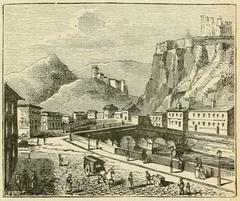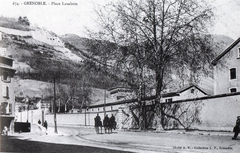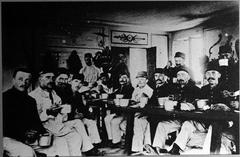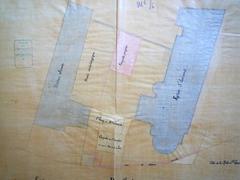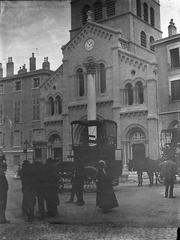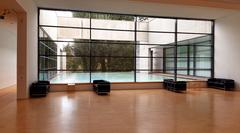Théâtre Municipal De Grenoble: Visiting Hours, Tickets, and Guide to Grenoble Historical Sites
Date: 04/07/2025
Introduction
Situated in the vibrant heart of Grenoble’s historic center, the Théâtre Municipal de Grenoble—commonly known as the Grand Théâtre—stands as a testament to the city’s enduring dedication to the performing arts. Established in 1768, this elegant Italianate venue is both an architectural gem and a dynamic hub for theater, dance, music, and circus arts. As a key institution in Grenoble’s cultural landscape, the theater balances its historic charm with a commitment to community engagement, innovation, and accessibility.
This comprehensive guide provides essential information for visitors, from the theater’s rich history and architectural highlights to practical details such as visiting hours, ticketing, accessibility, and nearby attractions. Whether you are a first-time visitor or a returning patron, discover everything you need to plan your visit and make the most of Grenoble’s cultural scene (Théâtre Municipal de Grenoble Official Site).
Table of Contents
- Introduction
- Historical Overview and Architectural Heritage
- Evolution and Modernization
- Cultural Significance and Community Engagement
- Practical Visitor Information
- Artistic Legacy and Notable Moments
- Nearby Attractions and Travel Tips
- Frequently Asked Questions (FAQ)
- Plan Your Visit
- References
Historical Overview and Architectural Heritage
The Grand Théâtre was inaugurated in 1768, reflecting Grenoble’s longstanding passion for the performing arts. Designed by architect Lhormé, it introduced the Italian-style horseshoe auditorium to the city, offering excellent acoustics and sightlines. The theater’s façade harmonizes with neighboring landmarks like the Collégiale Saint-André and the Palais du Parlement du Dauphiné, making it a focal point for both architecture and culture (grenoble.fr).
Throughout its history, the theater has adapted to changing tastes, hosting everything from Molière-inspired plays to contemporary productions. Renovations over the centuries have preserved its ornate plasterwork, gilded moldings, and grand ceiling medallion, while integrating modern lighting and technical systems to meet contemporary performance needs.
Evolution and Modernization
Since 2016, the Grand Théâtre has been part of the Théâtre Municipal de Grenoble (TMG) network, alongside Théâtre 145 and Théâtre de Poche. This collaboration has expanded the range of artistic offerings and fostered new partnerships with local artists and institutions. The theater now serves as the flagship venue for major productions, workshops, and community events, ensuring its continued relevance in Grenoble’s evolving cultural landscape.
Cultural Significance and Community Engagement
The Grand Théâtre is renowned for its eclectic programming, featuring theater, dance, music, and circus arts. The 2024–2025 season includes 36 productions—four new creations and seven shows for young audiences—with 19 companies in residence. The theater champions accessibility through solidarity-based ticket pricing (€5–€16), educational outreach, participatory events, and free access during initiatives such as European Heritage Days.
Under the leadership of Delphine Gouard since 2019, the theater has deepened its ties with local and regional partners, including MC2 and numerous festivals. This commitment to diversity and inclusivity has solidified the Grand Théâtre as a key player in Grenoble’s cultural and social life.
Practical Visitor Information
Visiting Hours
- Box Office: Tuesday to Saturday, 12:00 PM – 7:00 PM (extended on performance days)
- Performances: Evening shows typically begin at 8:00 PM; matinees at 3:00 PM on select days
- Hours may vary for special events; check the official website for the latest schedule.
Ticket Information
- Pricing: Standard tickets range from €5 to €16, with discounts for students, seniors, and groups. Special packages may be available (e.g., three shows for €50).
- Purchasing: Tickets can be bought online, by phone, or at the box office.
Accessibility
- Wheelchair access with reserved seating
- Hearing assistance devices on request
- Elevator access between levels
- Audio description and sign language interpretation available for select performances
- Staff assistance for visitors with reduced mobility; advance notice recommended
Getting There
- Address: 4 rue Hector-Berlioz / Place Saint-André, 38000 Grenoble
- Public Transport: Tram lines A and B, stops “Victor Hugo” or “Notre-Dame-Musée”
- Parking: Limited public garages nearby; public transport is recommended
Amenities
- Cloakroom: Available for coats and bags
- Bar/Café: Light refreshments before performances and during intermissions
- Restrooms: Including accessible facilities on both levels
- Programs & Souvenirs: Sold during major events
Special Events and Guided Tours
- Guided Tours: Offered periodically, focusing on the theater’s architecture and history; advance booking advised
- Workshops and Heritage Events: Free access during European Heritage Days and special participatory events throughout the year
Artistic Legacy and Notable Moments
The Grand Théâtre’s artistic legacy is rooted in its connections to historic troupes and its role as a breeding ground for emerging talent. From hosting descendants of Molière’s company at its opening to supporting contemporary creations today, the theater has maintained a tradition of excellence and innovation. Its intimate 543-seat auditorium fosters a close rapport between performers and audience, enhancing the theatrical experience.
Nearby Attractions and Travel Tips
Top Nearby Historical Sites
- Collégiale Saint-André: Gothic church neighboring the theater
- Palais du Parlement du Dauphiné: Former seat of regional parliament, open to visitors
- Musée de Grenoble: Renowned art museum, free permanent collection (France Voyager)
- Bastille Hill: Accessible by cable car, offering panoramic city views
- Place Victor Hugo: Bustling square with gardens, shops, and restaurants
Additional Tips
- Arrive Early: Explore the theater’s interior and nearby cafes before your show
- Dress Code: Smart-casual attire is recommended, especially for evening performances
- Language: Most performances are in French; some offer surtitles for non-French speakers
- Transportation: Grenoble’s center is walkable and well-served by trams and buses
Frequently Asked Questions (FAQ)
Q: What are the theater’s visiting hours?
A: Tuesday–Saturday, 12:00 PM–7:00 PM; extended on performance days.
Q: How can I buy tickets?
A: Online, by phone, or at the box office.
Q: Is the theater wheelchair accessible?
A: Yes, with reserved seating and staff assistance available.
Q: Are guided tours offered?
A: Yes, periodically and during special events.
Q: What public transport options are available?
A: Tram lines A and B, stops “Victor Hugo” and “Notre-Dame-Musée”.
Q: Are there discounts or special packages?
A: Yes, reduced rates for students, seniors, and group packages.
Plan Your Visit
Experience the intersection of history, architecture, and the performing arts at the Grand Théâtre. For the latest programs, ticket bookings, and guided tour information, visit the official TMG website and follow the theater on social media. Download the Audiala app for personalized event recommendations and up-to-date notifications.
Enhance your visit by exploring related articles and travel guides on Grenoble’s cultural sites (PlanetWare, Adventure Backpack).
Summary and Recommendations
The Théâtre Municipal de Grenoble is a cornerstone of the city’s cultural identity, offering a harmonious blend of historical architecture, dynamic programming, and inclusive community outreach. Its central location places visitors at the heart of Grenoble’s historic and artistic treasures. With ticket prices designed for broad accessibility, excellent public transport links, and a diverse slate of performances, the Grand Théâtre is an essential stop for anyone seeking to engage with the city’s vibrant cultural scene.
Plan ahead, explore nearby attractions, and immerse yourself in the living history and artistry that define Grenoble’s Grand Théâtre (Official TMG Website).
References
- Visiting the Théâtre Municipal de Grenoble: Hours, Tickets, and Cultural Highlights, 2024 (https://www.grenoble.fr/44-tmg-theatre-municipal-de-grenoble.htm)
- Visiting the Théâtre Municipal De Grenoble: Architectural Highlights, Tickets, Hours, and Nearby Attractions, 2024 (https://www.grenoble.fr/69-grand-theatre.htm)
- Visiting the Théâtre Municipal de Grenoble: A Cultural Landmark in the Heart of Grenoble, 2024 (https://www.grenoble.fr/actualite/7/68-une-nouvelle-saison-s-annonce-au-tmg.htm)
- Théâtre Municipal De Grenoble Visiting Hours, Tickets, and Nearby Attractions, 2024 (https://francevoyager.com/best-things-to-do-in-grenoble-france/)
- PlanetWare’s guide to Grenoble (https://www.planetware.com/tourist-attractions-/grenoble-f-rh-gren.htm)
- Adventure Backpack’s landmark overview (https://adventurebackpack.com/grenoble-landmarks/)

